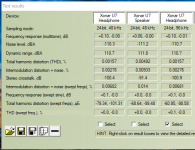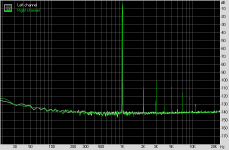The best audio ADC is still the AK5394A.
Yes, if 192kHz is enough, but unfortunately - it is NRND 🙁
One thing to take into account is that for in depth loudspeaker measurements, a very constant delay between soundcard output and input is very important. This was also pointed out by Kimmo Saunisto in the ARTA thread. Because of this, a pure ADC device without DAC (meaning you'll need to use two separate devices) might be limiting for certain measurements.
Just making sure....
Anyway, discussing ADC Chips without recommending a valid USB Soundcard to the TO might not be very useful to him...
Just making sure....
Anyway, discussing ADC Chips without recommending a valid USB Soundcard to the TO might not be very useful to him...
Also if some form of digital distortion compensation were considered, the incoming signal should be of precisely controlled frequency, synchronous with the ADC sampling clock. It is not possible to measure frequency with "infinite" precision in finite (plus short) time. Limiting the output signal to integer Hz and having DAC clock synchronous with ADC (i.e. a duplex device with single clock = typical soundcard) solves the problem.
One thing to take into account is that for in depth loudspeaker measurements, a very constant delay between soundcard output and input is very important. This was also pointed out by Kimmo Saunisto in the ARTA thread. Because of this, a pure ADC device without DAC (meaning you'll need to use two separate devices) might be limiting for certain measurements.
This is true for "single channel" measurements only. Also, software (operating system!) may introduce additional delays that are variable from one measurement to the next. The way out implemented in most software for audio testing is to do "dual channel" measurement (aka. "loopback"), which removes this issue even if the audio delay is very unpredictable.
Is dual channel possible with two different devices?
USB Microphone input and a signal output on a separate device seem not to fulfill the requirements, Kimmo did some tests.
USB Microphone input and a signal output on a separate device seem not to fulfill the requirements, Kimmo did some tests.
The clocks for all channels/both directions must be synchronized. For multiple soundcards that is satisfied only for very specific cases (USB adaptive soundcards connected to the same USB controller, or cards clocked by single external clock, or the second card slaved to the first card clock). Plus there could be a small fixed delay between each soundcard which could vary every time the stream is started.
IMO too much of a hassle for little gain. A regular stereo duplex soundcard configuration is OK.
IMO too much of a hassle for little gain. A regular stereo duplex soundcard configuration is OK.
Depending on your software you can use separate devices for source and measurement. But a two channel ADC is important/required for phase sensitive measurements. Even so it can be challenging. Measuring Bluetooth speakers using chirps is really difficult since the BT link goes dead between chirps and restarts with a different latency every time it connects. Still it can be done.
The clocks for all channels/both directions must be synchronized. For multiple soundcards that is satisfied only for very specific cases (USB adaptive soundcards connected to the same USB controller, or cards clocked by single external clock, or the second card slaved to the first card clock). Plus there could be a small fixed delay between each soundcard which could vary every time the stream is started.
IMO too much of a hassle for little gain. A regular stereo duplex soundcard configuration is OK.
As long as the left and right channels within the DAC and the ADC chips are time aligned, the dual channel / loopback technique will take care of the delays in the measurement chain (assuming the loopback implementation in the test software does not have any limitations to this). While one channel is used to send a signal to the device under test (DUT) and record it's response, the reference channel (REF) uses a direct wire from the DAC output to the ADC input. The relative time difference between the signals recorded by the ADCs of the DUT and REF channels is the time delay (=excess phase) of the DUT. With acoustic speaker tests, this includes the "flight time" of the sound traveling from a speaker to the microphone. The precision of this time delay is mainly determined by the sampling frequency. For fs = 44 kHz, the time resolution is 1/fs = 23 micro seconds, or for fs = 192 kHz it is 5.2 micro seconds.
It would be very awkward if the left and right channels of a DAC or ADC chip were not time aligned, as this would defeat the purpose of stereo audio, which was invented some time 140 years ago. If a 2019 audio DAC or ADC chip does not have left/right channels aligned, I'd consider the device to be broken.
mbrennwa, I agree entirely. My reply was to the post
USB microphone input may imply a mono capture channel, many USB soundcards (as well as notebook internal ones) have it like that. The idea could perhaps have been to use two soundcards with mono inputs joined into one dual-channel, hard to tell. That is why I reacted.
Using separate stereo DAC and ADC devices is OK, unless you want to co-ordinate both sides precisely, e.g. to further condition the captured signal. In such case I need to know the exact frequency with relation to samplerate which is impossible without having the DAC and ADC timed by the same clock (or at least two clocks PLLed to the same reference as is the case for two adaptive USB soundcards connected to the same controller).
USB Microphone input and a signal output on a separate device seem not to fulfill the requirements, Kimmo did some tests.
USB microphone input may imply a mono capture channel, many USB soundcards (as well as notebook internal ones) have it like that. The idea could perhaps have been to use two soundcards with mono inputs joined into one dual-channel, hard to tell. That is why I reacted.
Using separate stereo DAC and ADC devices is OK, unless you want to co-ordinate both sides precisely, e.g. to further condition the captured signal. In such case I need to know the exact frequency with relation to samplerate which is impossible without having the DAC and ADC timed by the same clock (or at least two clocks PLLed to the same reference as is the case for two adaptive USB soundcards connected to the same controller).
mbrennwa, I agree entirely. My reply was to ... USB microphone input may imply a mono capture channel, many USB soundcards (as well as notebook internal ones) have it like that.
Aha, ok, yes, that's a valid point!
I've actually gotten pretty good measurements with my Asus Xonar U7. I could post some measurements here if you're interested.
You could also do what I did: convince your employer that it's a good idea to buy an Audio Precision APx555, then shamelessly use it for your personal projects on nights and weekends...
You could also do what I did: convince your employer that it's a good idea to buy an Audio Precision APx555, then shamelessly use it for your personal projects on nights and weekends...
I've actually gotten pretty good measurements with my Asus Xonar U7. I could post some measurements here if you're interested.
Very much, thanks a lot.
You could also do what I did: convince your employer that it's a good idea to buy an Audio Precision APx555, then shamelessly use it for your personal projects on nights and weekends...
Do I understand correctly your employer is TI? I would expect there are a few APs in that company 🙂
Very much, thanks a lot.
Do I understand correctly your employer is TI? I would expect there are a few APs in that company 🙂
We have a lot of them here at the facility in Tucson, and even more in Dallas. But when we were developing the OPA1622 I made a convincing argument that the SYS-2722s that we had weren't good enough, and we needed the 555 🙂
Of course that AP has paid for itself many times over now, and was a great investment for the business.
Sorry for the long wait to post some measurements of my Xonar U7. Some basic loopback tests with RMAA are attached. I played around for a little while to get the best performance possible. Much to my surprise, the THD is better when using the headphone output, as opposed to the RCA outputs on the back of the unit. Sample rate did not have much of an effect on THD, results for both 48 and 96kHz sampling rates are shown.
I will admit, I thought I remembered the performance of this unit being better. But these are the best results I could get.
I will admit, I thought I remembered the performance of this unit being better. But these are the best results I could get.
Attachments
That's pretty good I would say! Considering they are only 60-80 EUR. You used line in on the U7 also, right?
Anyone come across a USB interface that can operate with 192kHz bandwidth (384k/s) ? The only ones I can identify is a ADI-2 Pro FS (but I can't seem to find any detailed specs on it) and the Steinberg AXR4 with 4x instrument inputs.
steinberg ur22, it will do full duplex in stereo at 24bit and 192kHz sample rate, works like a charm! seems discontinued now, however.
i made a ton of adapter cables for mine, including croco clips into XLR and others, measured a lot.... and havent killed the inputs so far 😀
i made a ton of adapter cables for mine, including croco clips into XLR and others, measured a lot.... and havent killed the inputs so far 😀
I was hoping for 384k/s sampling, although it looks like a 192kHz bandwidth from the ADC/DAC then shows up the next limitation relating to opamp bandwidth which seems to limit equipment bandwidth to under about 140kHz - so some improvement from 96kHz bandwidth, but not pro-rata with sampling rate for commercial product.
- Home
- Design & Build
- Equipment & Tools
- Current recommended USB sound cards for ADC and measurements?

